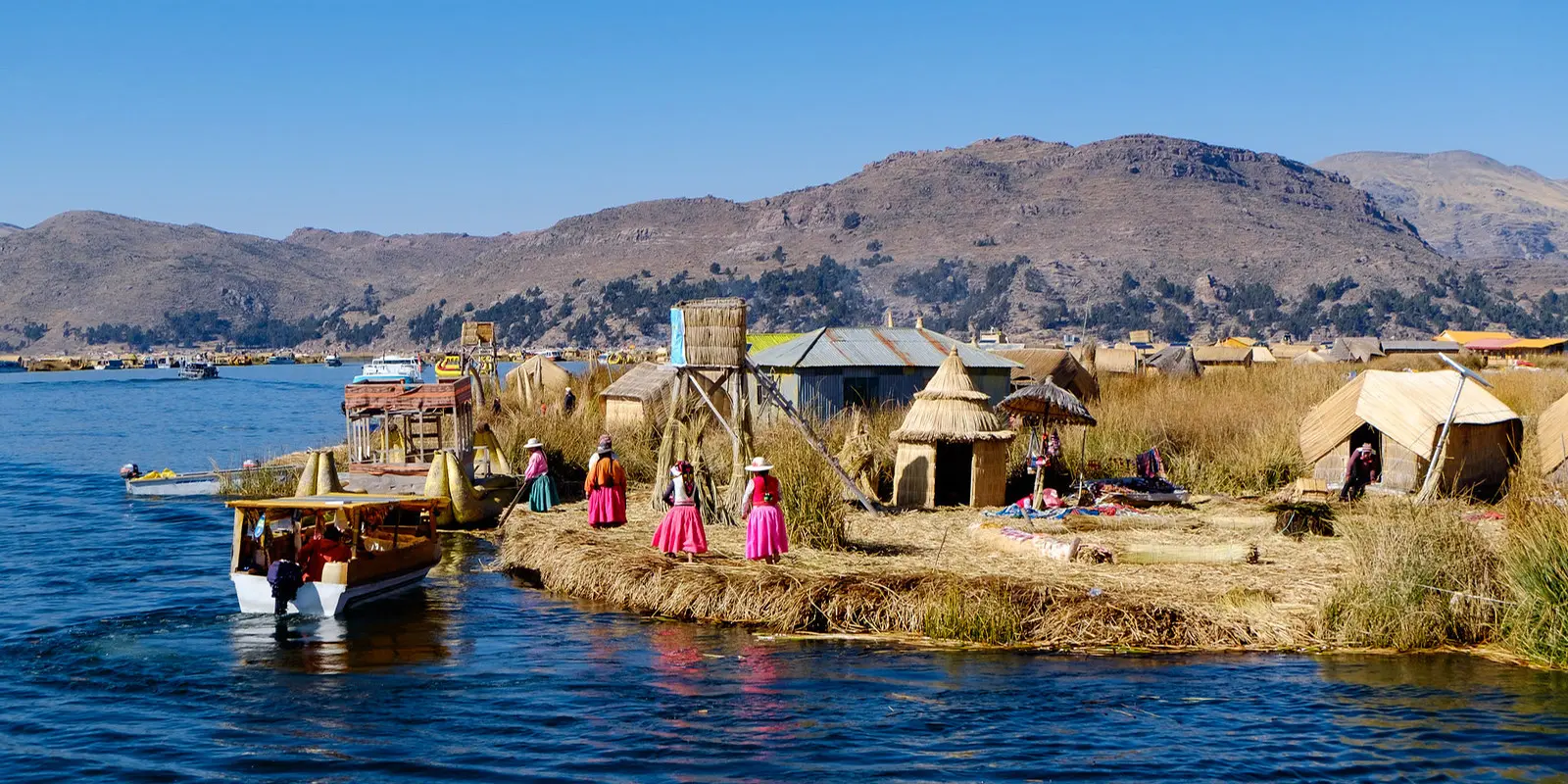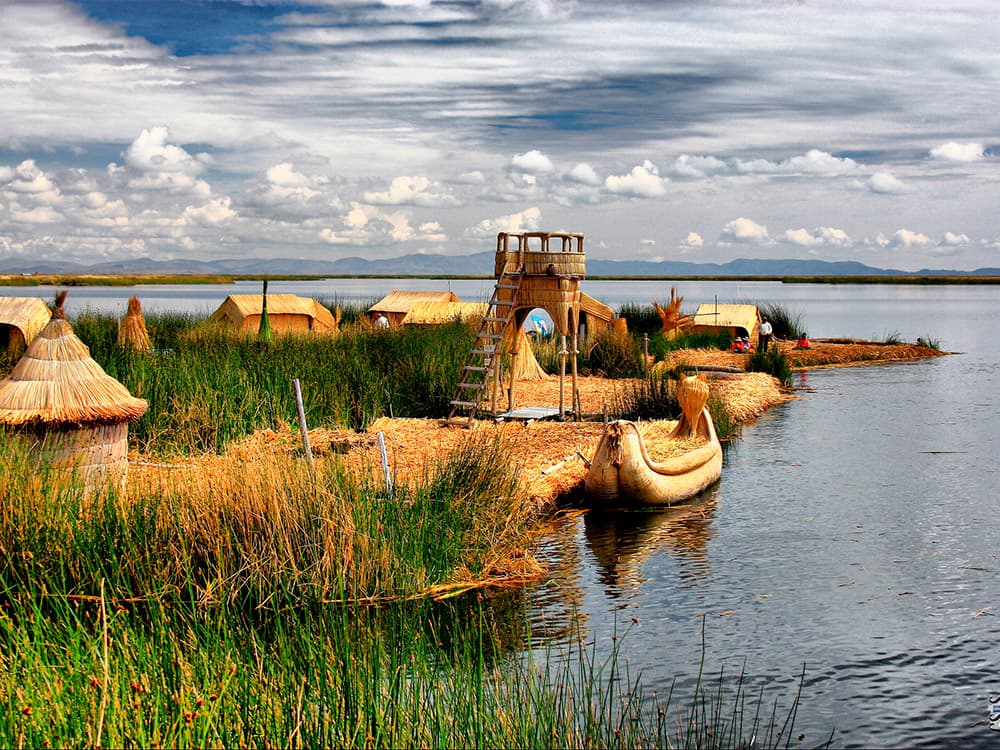
The floating Uros Island occupy a small corner of the world’s highest navigable lake, Lake Titicaca. It’s fair to say that there is no other place like it on earth.
So, how do the Uros Islands float? What are they made of? What’s the best way to scratch a trip to Lake Titicaca, the largest lake in South America, off your bucket list?
History of the Uros Islands

The Uro or Uros people are believed to be descended from the earliest inhabitants of Lake Titicaca. They’ve preserved a floating lifestyle for hundreds of years. To protect themselves from invading groups, the Uros built mobile islands from the endemic totora plant. If a threat emerged, they could simply move their islands elsewhere in the lake. While this worked for a while, both the Incas and Spanish eventually discovered their islands.
The Uru are descendants of one of the most ancient cultural groups in the Americas and little is known about their mysterious history. Legend has it that the Uru people are descended from the speakers of the now extinct Pukina language. Their native Uru language was abandoned around five hundred years ago as they continued to trade and intermarry with the mainland Aymara tribe, and the Urus people now communicate primarily in the native Aymara language. Although they lost their native language, they have maintained many other unique aspects of their original culture.
The Uros Islands are floating on the Peruvian side of Lake Titicaca, a few miles from Puno, the main city on the lakeshore. The islands used to be closer to the middle of the lake, but they moved or rebuilt closer to the shore following a devastating storm in 1986.
Culture of the Uros Islands
Peru is home to approximately 2,000 Uros people. Around 1,200 still live on the floating islands of Lake Titicaca. Harvested from vast beds that grow in abundance on the lake, the humble totora plant forms the backbone of Uros life. Homes, boats, and the islands themselves are all made of totora reeds.
As they have for generations, the Uros subsist primarily by fishing, bird hunting, and gathering bird eggs from the reed beds. Children are able to attend kindergarten and elementary school on Uros. However, older children continuing their education must head to the mainland.
These days, the Uros earn income through tourism. This has brought a few modern conveniences to the archipelago, including improved sanitary facilities and solar panels which reduce the risk of fires from open flames. They have embraced modern technology, with most islanders using cell phones and televisions powered by the solar panels.
See our unique package to explore Cusco and the Lake Titicaca here!
How the Floating Islands of Lake Titicaca are Built
To make an island, the Uros people create a sturdy but light base tying together layers of totora roots. Totora roots are naturally buoyant at the time of harvest. The roots float to the surface of the lake during the rainy season between November and March. Uros men are in charge of collecting the best roots for their islands. If the roots have too much soil, they will sink.
Above the totora root base, many layers of totora reeds are bundled and stacked. They anchor the islands in one place with rope and Eucalyptus stakes driven into the bottom of the lake. The islanders can maintain each island for up to 30 years, adding new layers of reeds once a week during the rainy season and once a month during the dry season.
Between 60 and 100 of these man made floating islands are still in existence, but the number is not constant. For instance, the islands can combine or separate, deteriorate over time, or the islanders can build new ones.
How to Visit the Uros Islands
The best way to visit the Uros Islands is a guided tour from Puno, Peru. Guided tours depart to Uros every day of the year from the Puno pier. Most boats depart in the morning between 7 and 8 AM for a 20 minute ride to the islands. Puno is easily accessible from Cusco, Arequipa, and La Paz, Bolivia. Cusco and Puno are well connected with four transportation options. From Arequipa, Colca Canyon tours can continue onto Puno by van. Buses run daily to and from La Paz.
Uros Floating Islands Tours
Each tour of Uros begins with a demonstration on how the islands are made. After that, the islanders invite their guests to visit a home built from the same Totora reeds. The islanders always present their handicrafts to tourists towards the end of each tour. While some visitors find this pushy, it is important to keep in mind that a large percentage of their income comes from selling souvenirs to tourists.
Uros Half-Day Tour
Duration: 3-4 hours. Morning, midday, or afternoon departures available.
What to Expect: Departing from the Puno city dock, travel about 20-30 minutes by boat to the main Uros archipelago. You’ll sail through thick reed beds to one of the islands where you can meet the resident families, explore your surroundings, and take tons of photos! You’ll also have the option to ride a reed boat to visit a neighboring island (for an additional cost of 10 soles per person; payment goes directly to the family that owns the boat).
Group vs. Private Tours: If you’re planning to make Uros the highlight of your trip to Lake Titicaca but don’t have time for a homestay, this is one case where it makes sense to spring for a private tour to Uros. With slower pacing, the private tour gives you time to converse with the islanders and learn more about their lifestyle beyond the standard cultural demonstration. Your guide will act as a translator if you can’t speak Spanish. In fact, many islanders only speak their native language, Aymara. You can also enjoy other activities like birdwatching in the surrounding Lake Titicaca National Reserve.
On the other hand, if you’d like to see as many of Lake Titicaca’s islands as possible (they’re all very different!), then an island-hopping tour is a great option.
Island Hopping Tours
Why stop at Uros only? Taquile, Amantani and Suasi islands each represent the wildly contrasting faces of Titicaca’s indigenous cultures. Choose from various tours visiting different combinations of islands. Itineraries range from full-day to 2d/1n or more, with lodging at local homestays or a luxurious Titicaca island retreat. Keep reading to see which one suits you best.
OPTION 1: THE FULL-DAY UROS AND TAQUILE ISLANDS TOUR
Duration: about 9 hours including boat travel time. Morning departure.
What to Expect: Taquile is distinct for its rich cultural heritage and beautiful textile traditions. The first stop on the tour is the Uros floating islands, after which your boat sails for about 2 hours to reach Taquile island. 500 steps lead from the shore to the main town plaza. It’s a challenge, but the views are amazing! After enjoying a traditional lunch, you’ll have some time to explore the island and fill your camera with snaps of the gorgeous landscape.
Return to Puno before sunset.
OPTION 2: THE UROS & TAQUILE TOUR WITH AMANTANI HOMESTAY
Duration: 2 days with 1 night on Amantani. Morning departure.
What to Expect: Because of its remote location, Amantani is the most popular choice for a Titicaca homestay. As bookends to this tour, you will visit Uros on Day 1 and Taquile on Day 2.
Tourism on Amantani has been in the hands of indigenous islanders since the beginning. As a result, homestay families are well-prepared to provide fun activities for their guests. You’ll meet your host family on arrival, settle into your comfortable room, and enjoy a day of cultural exchange, perhaps some high-altitude football, free time to hike trails to Inca ruins, and a dance party at night.
*** We do highly recommend to hike up to Pacha Tata Temple to explore the Ancient Tiawanaco temple and enjoy the amazing vistas.
OPTION 3: THE UROS TOUR WITH SUASI ECO-ESCAPE
Duration: Various itineraries available. Morning departure.
What to Expect: If blissing out at a luxurious eco-retreat on a private island in the middle of Lake Titicaca sounds like your cup of tea, then combine your trip to Uros with a stay on Suasi island. There’s one scheduled departure from Puno to Suasi every morning, with stops at Uros and Taquile along the way.
Powered by solar panels and built in harmony with the landscape, Suasi was designed as a place for utter relaxation. You can hike from high hills to empty beaches, kayak in the crystalline waters, enjoy the full service spa, or just laze on the hammocks and soak in the tranquil setting.
Rustic rooms are fully equipped, bright, spacious, and all have views of the lake from the terrace or balcony. For a truly magical experience, request a room with a skylight so that you can fall asleep with a view of the twinkling Milky Way galaxy. You can stay as many nights as you wish on Suasi before returning to Puno.
Uros Homestay
Duration: 2 days with 1 night on Uros. Morning departure.
What to Expect: “Interesting, but touristy,” is the opinion you’ll often hear from people who visit the Uros floating islands on a day trip from Puno. Some people come away feeling they were taken to the islands only to buy trinkets and watch staged “cultural demonstrations.”
A homestay on Uros liberates you from the typical experience. Homestay hosts invite their guests to participate in normal daily activities. After the standard tour, you can participate in activities with the locals. For example, go out on reed canoes, learn to harvest reeds, set out fishing nets in the afternoon and wake at dawn the next morning to bring in the catch. You can try your hand at making crafts or just sit and chat with your host family, sharing stories and perspectives.
Travel Tips
- The best time to visit the Uros Islands is during the dry season from April to November. April to May and September to November are nice options to take advantage of the good weather with lower numbers of tourists.
- Bring your passport for a souvenir stamp on one of the main islands (additional cost of 1 sol per stamp).
- Each tour of Uros visits two islands. You will have the option to take a handmade reed boat from first island to the second island on a 15-20 minute ride. This boat ride costs an additional 10 soles per person. This payment goes directly to the family that owns the boat.
- The Uros Islands and Lake Titicaca sit at 12,500 feet (3,810 meters) above sea level. It is best to acclimatize by first visiting lower altitudes in Arequipa or Cusco before heading to Lake Titicaca.
- Bring sun protection, warm layers, comfy shoes, and your camera on any tour of Uros Islands.
- The best time to depart on any Lake Titicaca tour is in the morning. Therefore, we recommend staying in a Puno hotel overnight before visiting the lake.
- Check out our full Lake Titicaca guide for more travel tips.
See all of our tour in Cusco and Machu Picchu here and explore with Orage Nation Peru!